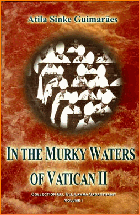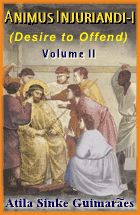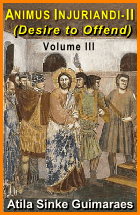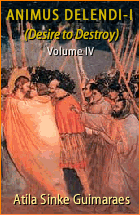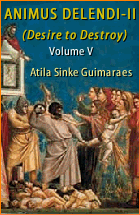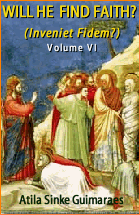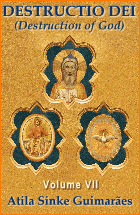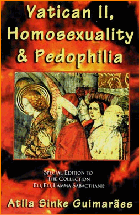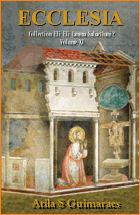About the Church
 |
 |
 |
 |
 |
 |
 |
The Holy Mass - Part IV
Slow & Gradual Changes Pave the Way
to the New Mass
The Vatican II Constitution Sacrosanctum Concilium on the Sacred Liturgy was officially ratified and promulgated by Pope Paul VI on December 4, 1963. Of the 16 conciliar documents this one concerning the Mass had a high priority; it was the first document to be discussed and then approved by the Council on November 14, 1962. (1) Changes occurred in the liturgy in a step by step process from 1963 to the introduction of the Novus Ordo in 1969.
This article will present a brief summary of how the progressivist liturgists slowly destroyed the very heart of the Church, which is the Mass.
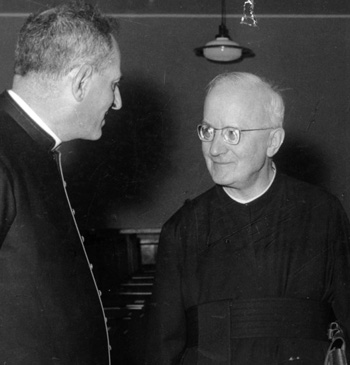 Sacrosanctum Concilium (SC) received almost unanimous approval from the Bishops of the Council. Although reservations were expressed by some of the Bishops, the relator Josef Jungmann responded saying that “due care was being taken to preserve the substance of the rites“ (probe servata eorum substantia). (2)
Sacrosanctum Concilium (SC) received almost unanimous approval from the Bishops of the Council. Although reservations were expressed by some of the Bishops, the relator Josef Jungmann responded saying that “due care was being taken to preserve the substance of the rites“ (probe servata eorum substantia). (2)
Here are some excerpts from Sancrosanctum Concilium that open the door for changes: (3)
A commission, a motu proprio & a decree
To deal with the practical implementation of the approved Constitution on the liturgy, Paul VI set up a new commission, the Consilium or Pontifical Commission for the Application of the Constitution on the Sacred Liturgy, on January 25, 1964. It was headed by Fr. Annibale Bugnini and included six Protestant minister-consultors.
On the same date, the motu proprio Sacram Liturgiam was promulgated. It mentions the Consilium as a vehicle “to revise the rites” and “prepare new liturgical books” over a long period of time. This ploy for time quieted the reaction of those conservative Bishops reluctant for change; at the same time it encouraged the impatient progressivists anxious for reform.
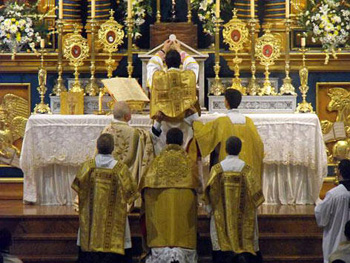
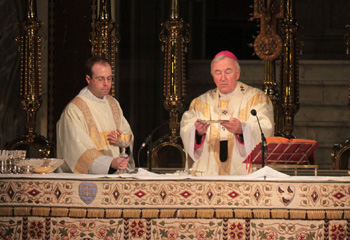
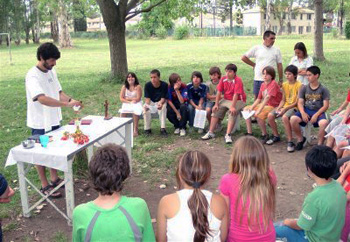 Nonetheless, the German and French Bishops vehemently protested that the motu proprio stymied their local attempts to translate the liturgy into the vernacular. Bugnini proposed a series of amendments establishing a commission of experts for each language that would make the translation, which would then be submitted to the Holy See for confirmation. (4)
Nonetheless, the German and French Bishops vehemently protested that the motu proprio stymied their local attempts to translate the liturgy into the vernacular. Bugnini proposed a series of amendments establishing a commission of experts for each language that would make the translation, which would then be submitted to the Holy See for confirmation. (4)
The conservatives surrendered to this “moderate” solution. This type of surrender became the rule as liturgical reform progressed.
On September 26, 1964, Inter Oecumenici, Instruction on the Proper Implementation of the Constitution of the Sacred Liturgy, was promulgated by the Sacred Congregation of Rites. This instruction set out “adaptations” to be practiced before the revision of the liturgical books.
It made significant changes to the existing liturgy, with the announced aim “to increase a full, active participation (5) and to make the liturgical rites, especially the Mass, clearer and better understood.” These changes included:
The changes continue
Changes to the liturgy continued to come, one after another, with little to no protests from the general clergy or faithful, who had become accustomed to these “adaptations” mandated by Vatican II and issued in the name of Paul VI.
A new rite for concelebration was called for the Council's Constitution on Liturgy (SC 58). On March 7, 1965, the decree Ecclesiae semper was issued, which introduced concelebration of the Mass and communion under both kinds. It also presented a new concept of the Mass “as an activity that belongs to the entire people of God.” (7)
Also in 1965, at the “urgent request of some Bishops' Conferences,” (8) Paul VI authorized the Preface of the Mass to be said in the vernacular; only the Canon then had to be said in Latin.
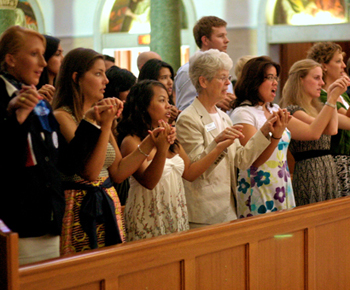 On September 25, 1965, the Letter De Missa vespere sabbati of the Congregation of Rites made formal the practice of substituting a Saturday evening Mass for the Sunday obligation.
On September 25, 1965, the Letter De Missa vespere sabbati of the Congregation of Rites made formal the practice of substituting a Saturday evening Mass for the Sunday obligation.
Two years after the close of the Council, the general norms of Musicam Sacram, Instruction on Music in the Liturgy, of March 5, 1967, encouraged the active participation of the people in singing, rejecting the strict use of Gregorian chant and traditional music. It was not long before this instruction was being interpreted as official permission for folk and popular music to be sung at the Mass. Today, as one knows, anything goes…
On May 4, 1967, the instruction Tres abhinc annos allowed the use of the vernacular in the whole Mass, including the Canon, and prescribed it be said audibly. Use of the maniple was made optional and the chasuble could replace the cope.
The laity were forbidden to genuflect at the “Incarnatus est” and the celebrant could no longer make the important three genuflections at the elevation of the consecrated Host and Wine. Only after the elevation could he genuflect. All seven Signs of the Cross from the Quam oblationem to the Consecration were abolished. (9) This was an onslaught on the sacred signs and gestures of reverence in the Tridentine Mass.
The list of mutilations to the Tridentine Mass is indeed long. The fact that this instruction met with little resistance indicated no large scale opposition was to be feared when the new Eucharistic prayers and the Novus Ordo Missae would appear.
As now-Archbishop Annibale Bugnini ecstatically declared: “The new song has begun and it will not cease.” (10)
The new Eucharistic prayers
The American Bishops were well conditioned to go along with whatever the International Commission on the English Liturgy (ICEL) deemed appropriate. On May 23, 1968, the decree Preces Eucharisticae was promulgated, which introduced three new Eucharistic prayers, or purported Canons along with the ancient Roman Canon, which was retained as Eucharistic Prayer n. 1. Thenceforth, four options of 'Canons' exist, and each Bishops Conference around the world could choose the one to be said in the Masses under its jurisdiction.
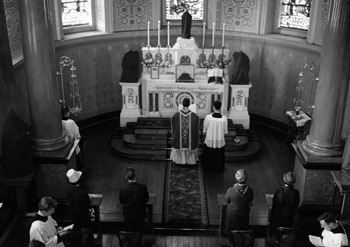 Bugnini was enthusiastic about these three new canons and praised them as “the first verses of this new canticle.” (11) The trio could be better termed “the Requiem for the Roman Rite.” In fact, a wholesale market opened on Eucharistic prayers, with more than 13 approved today by Rome for use in the United States alone. (12)
Bugnini was enthusiastic about these three new canons and praised them as “the first verses of this new canticle.” (11) The trio could be better termed “the Requiem for the Roman Rite.” In fact, a wholesale market opened on Eucharistic prayers, with more than 13 approved today by Rome for use in the United States alone. (12)
For some 1600 years previously, the Roman rite knew only one Eucharistic Prayer, the Roman Canon. These additions marked a radical change in the Roman Liturgy. With time, the shorter Eucharistic Prayer II came to be the most frequently used, even on Sunday. The first Eucharistic Prayer, which is the traditional one with some changes, is almost never used.
The time was now ripe for introducing the full Novus Ordo Missae. What it represented for the destruction of the Tridentine Mass will be addressed in the next article.
Continued

This article will present a brief summary of how the progressivist liturgists slowly destroyed the very heart of the Church, which is the Mass.

Jungmann, right, assured the Bishops 'due care' would be taken to preserve the traditional Mass
Here are some excerpts from Sancrosanctum Concilium that open the door for changes: (3)
- Preparing the way for a new liturgical simplicity: “In the revision of the liturgy, the following general norms should be observed: The rites should be distinguished by a noble simplicity; they should be short, clear, and unencumbered by useless repetitions; they should be within the people's powers of comprehension, and normally should not require much explanation.” (SC 34)
- Exaltation of Scripture to please the Protestants: “That the intimate connection between words and rites may be apparent in the liturgy, in sacred celebrations there is to be more reading from Holy Scripture, and it is to be more varied and suitable.” (SC 35)
- Encouraging use of the vernacular: Since the use of the mother tongue, whether in the Mass, the administration of the sacraments or other parts of the liturgy, frequently may be of great advantage to the people, the limits of its employment may be extended.” (SC 36)
A commission, a motu proprio & a decree
To deal with the practical implementation of the approved Constitution on the liturgy, Paul VI set up a new commission, the Consilium or Pontifical Commission for the Application of the Constitution on the Sacred Liturgy, on January 25, 1964. It was headed by Fr. Annibale Bugnini and included six Protestant minister-consultors.
On the same date, the motu proprio Sacram Liturgiam was promulgated. It mentions the Consilium as a vehicle “to revise the rites” and “prepare new liturgical books” over a long period of time. This ploy for time quieted the reaction of those conservative Bishops reluctant for change; at the same time it encouraged the impatient progressivists anxious for reform.

The Consilium gradually changed the Roman Mass, first keeping some symbols and pomp, below ...

... but before long, anything was permissible, as seen below at an outdoor Mass in the 1970s

The conservatives surrendered to this “moderate” solution. This type of surrender became the rule as liturgical reform progressed.
On September 26, 1964, Inter Oecumenici, Instruction on the Proper Implementation of the Constitution of the Sacred Liturgy, was promulgated by the Sacred Congregation of Rites. This instruction set out “adaptations” to be practiced before the revision of the liturgical books.
It made significant changes to the existing liturgy, with the announced aim “to increase a full, active participation (5) and to make the liturgical rites, especially the Mass, clearer and better understood.” These changes included:
- The entire Mass except for the Preface and the Canon to be said in the vernacular;
- The readings done facing the people and read by a layman;
- Removal of the “Judica me” at the prayers at the foot of the altar;
- The prayer of the faithful may be introduced after the Creed;
- The celebrant and the congregation recite the Pater Noster together;
- The abbreviated words “Corpus Christi” [Body of Christ] said by the Priest in distributing Holy Communion and the communicant to respond with “Amen.”
- The omission of Last Gospel of St. John and prayer added by Leo XIII. (6)
The changes continue
Changes to the liturgy continued to come, one after another, with little to no protests from the general clergy or faithful, who had become accustomed to these “adaptations” mandated by Vatican II and issued in the name of Paul VI.
A new rite for concelebration was called for the Council's Constitution on Liturgy (SC 58). On March 7, 1965, the decree Ecclesiae semper was issued, which introduced concelebration of the Mass and communion under both kinds. It also presented a new concept of the Mass “as an activity that belongs to the entire people of God.” (7)
Also in 1965, at the “urgent request of some Bishops' Conferences,” (8) Paul VI authorized the Preface of the Mass to be said in the vernacular; only the Canon then had to be said in Latin.

An Instruction on Sacred Music encourages active participation in singing at Mass
Two years after the close of the Council, the general norms of Musicam Sacram, Instruction on Music in the Liturgy, of March 5, 1967, encouraged the active participation of the people in singing, rejecting the strict use of Gregorian chant and traditional music. It was not long before this instruction was being interpreted as official permission for folk and popular music to be sung at the Mass. Today, as one knows, anything goes…
On May 4, 1967, the instruction Tres abhinc annos allowed the use of the vernacular in the whole Mass, including the Canon, and prescribed it be said audibly. Use of the maniple was made optional and the chasuble could replace the cope.
The laity were forbidden to genuflect at the “Incarnatus est” and the celebrant could no longer make the important three genuflections at the elevation of the consecrated Host and Wine. Only after the elevation could he genuflect. All seven Signs of the Cross from the Quam oblationem to the Consecration were abolished. (9) This was an onslaught on the sacred signs and gestures of reverence in the Tridentine Mass.
The list of mutilations to the Tridentine Mass is indeed long. The fact that this instruction met with little resistance indicated no large scale opposition was to be feared when the new Eucharistic prayers and the Novus Ordo Missae would appear.
As now-Archbishop Annibale Bugnini ecstatically declared: “The new song has begun and it will not cease.” (10)
The new Eucharistic prayers
The American Bishops were well conditioned to go along with whatever the International Commission on the English Liturgy (ICEL) deemed appropriate. On May 23, 1968, the decree Preces Eucharisticae was promulgated, which introduced three new Eucharistic prayers, or purported Canons along with the ancient Roman Canon, which was retained as Eucharistic Prayer n. 1. Thenceforth, four options of 'Canons' exist, and each Bishops Conference around the world could choose the one to be said in the Masses under its jurisdiction.

A vernacular Mass said in Ireland in 1965 - still with traditionalist trappings that will soon disappear
For some 1600 years previously, the Roman rite knew only one Eucharistic Prayer, the Roman Canon. These additions marked a radical change in the Roman Liturgy. With time, the shorter Eucharistic Prayer II came to be the most frequently used, even on Sunday. The first Eucharistic Prayer, which is the traditional one with some changes, is almost never used.
The time was now ripe for introducing the full Novus Ordo Missae. What it represented for the destruction of the Tridentine Mass will be addressed in the next article.
Continued
- Atila S. Guimaraes, In the Murky Waters of Vatican II, Maeta: 1999, p. 217.
- Fr. Cassian Folsom, O.S.B., “From One Eucharistic Prayer to Many: How it Happened and Why,” Adoremus, nn. 4-6, Sept-Nov 1996
- Guimaraes presents a more complete list of texts from SC that, because of their ambiguous language, open the way for the change in the Mass and facilitate ecumenism, In the Murky Waters of Vatican II, pp. 218-220.
- Msgr. Piero Marini, A Challenging Reform: Realizing the Vision of the Liturgical Renewal, 1963-1975, Collegeville, MN: Liturgical Press, 2007, pp. 15-29
- Active participation in the liturgy via the dialogue Mass before and after Vatican II is discussed at length by Dr. Carol Byrne in a series of excellent articles published on the TIA website (here). She shows the long and steady path toward the New Mass that began in the early 20th century with promoters of the liturgical movement in Belgium led by Dom Lambert Beauduin. This Liturgical Movement gained impulse under Pius XI and Pius XII, who effectively prepared the way for Vatican II by supporting Fr. Annibale Bugnini and making changes to the Holy Week liturgy in 1955.
- James F. White, Roman Catholic Worship: Trent to Today, Liturgical Press, 2003, p. 131
- The Liturgy Documents: Supplemental Documents for Parish Worship, Devotions, Formation and Catechesis, Liturgy Training Pub, 2013, pp. 196-197
- Card. Francis Arinze, “Latin and Vernacular: Language in the Roman Liturgy,” keynote address at the Gateway Liturgical Conference, St. Louis, Mo, November 11, 2006.
- Fr. Paul Trinchard and Dr. Remi Amelunxen, New Mass in Light of the Old, Marian Pub, 1995, pp.22-26.
- Ibid.
- Ibid.
- In the Sacramentary there are nine, which include the four universal Eucharistic Prayers, three for children, and two for Masses of Reconciliation, added in 1974. Four others, included in the Swiss canon and added in 1994, are called: The Church on the Way to Unity, God Guides the Church on the Way of Salvation, Jesus Way to the Father, Jesus the Compassion of God.

Posted September 28, 2015



